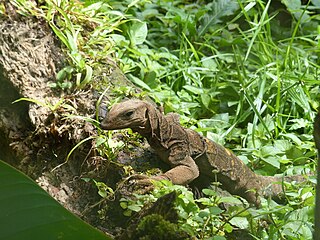
The Varanidae are a family of lizards in the superfamily Varanoidea. The family, a group of carnivorous and frugivorous lizards, includes the living genus Varanus, the extinct Megalania, and a number of other extinct taxa. Varanus includes the Komodo dragon, crocodile monitor, savannah monitor, the goannas of Australia and Southeast Asia, and various other species with a similarly distinctive appearance. Their closest living relatives are the anguid and helodermatid lizards.

Monitor lizards are large lizards in the genus Varanus. They are native to Africa, Asia, and Oceania, but are now found also in the Americas as an invasive species. There are about 80 recognized species.

Megalania refers to an extinct giant goanna or monitor lizard, recognised as either Megalania prisca or Varanus priscus. They were part of the megafaunal assemblage that inhabited southern Australia during the Pleistocene. The youngest fossil remains dated to around 50,000 years ago. The first aboriginal settlers of Australia might have encountered them and been a factor in their extinction.

Ampelosaurus is a titanosaurian sauropod dinosaur hailing from the Late Cretaceous Period of what is now Europe. Its type species is A. atacis, named by Le Loeuff in 1995. A possible unnamed species has given Ampelosaurus an age reaching to the latest Cretaceous, from about 70 to 66 million years ago.

The emerald tree monitor or green tree monitor, is a small to medium-sized arboreal monitor lizard. It is known for its unusual coloration, which consists of shades from green to turquoise, topped with dark, transverse dorsal banding. This coloration helps camouflage it in its arboreal habitat. Its colour also makes the emerald tree monitor highly prized in both the pet trade and zoos alike.
Palaeosaniwa canadensis is an extinct species of carnivorous lizard from the late Cretaceous of North America. The name, given by Charles Whitney Gilmore in 1928, means "ancient Saniwa from Canada".

The peach-throated monitor, also known commonly as the Sepik monitor, is a species of monitor lizard in the family Varanidae. The species is native to New Guinea.
The Pilbara monitor, also known as Bush's monitor, is a species of monitor lizard in the family Varanidae. The species is endemic to Australia.
The turquoise monitor, Varanus caerulivirens, is a species of monitor lizards found in Indonesia. Specifically, it is found on Halmahera Island and in the Maluku Islands.

The Ceram mangrove monitor, Varanus cerambonensis, is a species of monitor lizards found in Indonesia. Specifically, it is found on some of the central Moluccan Islands including: Ambon, Seram, Obi, Buru, and Banda. On Ambon and probably on New Guinea V. cerambonensis occurs sympatrically with Varanus indicus. It is in the indicus species group of the subgenus Euprepiosaurus.

The blue-tailed monitor, blue-tailed tree monitor or Kalabeck's monitor, is a monitor lizard of the Varanidae family. It belongs to the V. doreanus group of the subgenus Euprepiosaurus.
The sago monitor or torch monitor, Varanus obor, is a species of monitor lizards endemic to the Indonesian island of Sanana.
The canopy goanna is a species of monitor lizards native to northeast Australia. It is also known as the blue-nosed tree monitor, Keith Horne's monitor, or occasionally as the Nesbit River monitor It belongs to the subgenus Euprepiosaurus and is a member of the Varanus prasinus species group.
Finsch's monitor is a species of monitor lizard in the family Varanidae. The species is found in New Guinea and Australia.
The Rennell Island monitor is a species of monitor lizards found in the Solomon Islands archipelago. It is also known as the Hakoi Monitor. It belongs to the subgenus Euprepiosaurus along with the canopy goanna, the peach-throated monitor, Kalabeck's monitor, and others.

Varanus kordensis, the Biak tree monitor, is a member of the Varanidae family found on Biak Island in Indonesia. It is also known as the Kordo tree monitor. Long considered a subspecies of the emerald tree monitor, most authorities now treat it as a separate species.
Aiolosaurus is an extinct genus of monitor lizard from the Late Cretaceous of Mongolia. The type and only species, Aiolosaurus oriens, was named in 2000 from Ukhaa Tolgod, a rich fossil site in the Campanian-age Djadochta Formation.

Saniwa is an extinct genus of varanid lizard that lived about 48 million years ago during the Eocene epoch. It is known from well-preserved fossils found in the Bridger and Green River Formations of Wyoming, and evidence indicates Saniwa also lived in Europe. The type species S. ensidens was described in 1870 as the first fossil lizard known from North America. Several other species have since been added, but their validity is uncertain. It is a close relative of Varanus, the genus that includes monitor lizards.

Galeamopus is a genus of herbivorous diplodocid sauropod dinosaurs. It contains two known species: Galeamopus hayi, known from the Late Jurassic lower Morrison Formation of Wyoming, United States, and Galeamopus pabsti, known from the Late Jurassic fossils from Wyoming and Colorado. The type species is known from one of the most well preserved diplodocid fossils, a nearly complete skeleton with associated skull.

Varanus spinulosus, the spiny-necked mangrove monitor, is a species of monitor lizard.













